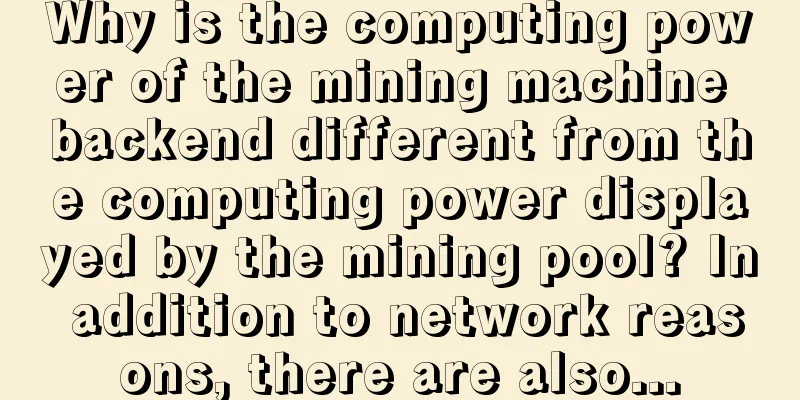Why is the computing power of the mining machine backend different from the computing power displayed by the mining pool? In addition to network reasons, there are also...

|
Recently, I often see miners in various groups asking why the computing power displayed on the mining machine backend is different from that displayed by the mining pool. Has the computing power been stolen? Relax, that is the worst-case scenario after all. In fact, it is normal that the computing power displayed by the mining machine backend is different from that displayed by the mining pool. It is hard to say which one is higher or lower. I decided to talk about this with everyone. (Figure 1: The mining machine background displays the computing power chart) (Figure 2, mining pool display computing power chart) Before that, let me briefly explain the working principle of the mining machine connecting to the mining pool (non-novice users can ignore it) : Mining is like doing a "calculation problem". For example, the calculation problem of a certain block is A+X, A is fixed, and X is unknown. All miners need to keep adding 1, +2, +3, +······ to collide until they hit X. It takes a long time for a miner to add a certain number one by one until the correct +X is added. The role of the mining pool is to assign jobs of different difficulty (such as calculation tasks) to miners according to the computing power of the mining machine. Those with small computing power will add 1~100, and those with large computing power will add 101~500. After receiving the task, the miner will start to calculate, and then return the share (that is, the answer) to the mining pool through the network. The mining pool will use the "answer" to try which one is X. If it is correct, the block will be exploded, and everyone is happy. The mining pool will then send the mining machine a calculation problem for the next block, and so on. After explaining the principle, I will get to the point and talk about several reasons why the computing power of the mining machine background is inconsistent with the computing power displayed by the mining pool. 1. The update time of computing power displayed by mining machines and mining pools is different Normally, the update time of the computing power of the mining pool and the mining machine is inconsistent. For example, the real-time computing power displayed by our CoinIn mining pool is the average computing power of the last 15 minutes, and the calculation time of other mining pools varies from 10 to 30 minutes. The computing power displayed by the mining machine in the hands of the miner may be refreshed every 5 seconds, which leads to the difference in the computing power on both sides. When the computing power is normal, the difference between the two data will not be too large. When the computing power fluctuates greatly due to the machine or other external reasons, the difference between the two data will appear to be particularly large. 2. The rejection rate is caused by network reasons, and the mining pool only displays the real effective computing power Let’s talk about the rejection rate first. Because the “answer” returned by the mining machine is through the network, when the network environment is poor, network fluctuations during the transmission process will cause the mining pool to receive incomplete “answers” (packet loss) and reject them; or the “answer” of the previous calculation problem has not been transmitted to the mining pool, and the mining pool has already exploded the block to proceed to the next “calculation problem”, then this “answer” does not meet the new standard and will also be rejected by the mining pool; even if the “answer” is not received, the real effective computing power will be significantly reduced; Rejection number/total submission number = rejection rate, that is, the number of "answers" received by the mining pool is not equal to the number of "answers" sent by the mining machine to the mining pool, and the real effective computing power of the mining machine will be low. In order to give miners a more intuitive way to calculate the benefits, the computing power displayed by our CoinIn mining pool refers to the real effective computing power received, while many mining pools display the computing power converted from all "answers" sent by the mining machine to the mining pool (regardless of whether they are valid, they are recorded by the mining pool) . This also explains why the computing power of many mining pools is obviously large, but the benefits are low. If the rejection rate is high, it is recommended to check the network environment. Common scenarios include: 1) All machines in the same router or switch exceed the limit: It is recommended to check the entire network and try replacing the router or switch. 2) If some machines exceed the limit, it is recommended to replace the network cable and network port connected to the machine. 3. The calculation method of computing power between mining machines and mining pools is inconsistent The backend computing power GH/s (RT) of most mining machines is inferred from the frequency of the computing board : each mining machine has N computing boards, and the computing power of each computing board can be inferred from the frequency of each computing board, and the computing power of the mining machine is obtained by adding the computing power of these N computing boards. The point is that sometimes the computing board is offline and does invalid work, and the computing power will still be calculated by some mining machines. The mining pool cannot receive this part of the "answer", so of course there will be a computing power difference. As shown in the figure below, if a computing board of some mining machines is offline, xxxxxxxxx will appear in the last column (red circle), which means there is no real computing power. 4. Instability of mining machine power supply and voltage The computing power submitted by the mining machine to the mining pool is related to the stability of the power supply and voltage. Instability will lead to insufficient power supply and increased rejection rate. This is caused by hardware problems. Please check the power supply of the mining machine when it occurs. As shown in the above figure, the mining machine background will normally display the rejected tasks (rejected column). This is the statistics of the machine itself, that is, this part of the share was rejected during the controller verification and was not connected to the mining pool, so the mining pool will show a very low computing power with a 0 rejection rate. 5. Computing power is stolen by third-party software In extreme cases, which we don't want to encounter, is the use of third-party software, especially when mining with graphics cards, mining software will be used. Bad software developers will quietly hijack a small part of the computing power for private use. At this time, the only way to avoid it is to choose reputable software on the market. 6. After flashing the "problematic firmware", the impact of the firmware on the mining machine The "problematic firmware" factor refers to the fact that many users will choose to flash some overclocking firmware or other malicious firmware of unknown origin. This kind of firmware causes the mining machine to work in overclocking for a long time, which causes great damage to the hardware of the mining machine. The damage to the hardware will inevitably lead to a decrease in computing power, and there is also a risk of computing power being stolen. Okay, I have explained the most common situations. You should all know that it is normal for the computing power displayed by the mining pool to be slightly different from the computing power displayed by the mining machine backend. |
<<: Why are some blocks not packaged with transactions? Did the miners forget?
>>: Vitalik Buterin's Cryptocurrency Configuration Revealed! How to Invest Like Him?
Recommend
What kind of face will make a woman lucky in marriage?
Women who are lucky in bringing good luck to thei...
The market fell below the triangle, and the future direction has been determined
Author | Hashipi Analysis Team...
A person with a more delicate mind
People who are thoughtful are more able to discov...
Chinese hackers and Bitcoin ransomware
Comment: Although the attacks on US companies hav...
What does the M pattern on the palm represent?
In palmistry , many lines on the palm have their ...
What is the personality of a girl with a big mouth?
Women with thick and big mouths do have clear lik...
Which faces always look sad have deep eye sockets?
A person's facial expressions change with the...
What is the fate of a woman with thin eyebrows? She will have good luck when her love is happy!
What does a woman with long and thin eyebrows loo...
How to read the marriage line in a woman's palm
The marriage line in a woman's palm is relate...
A face with shifty eyebrows and rat eyes is not a good bird
It is said that the appearance is given by parent...
Judging a woman's fortune from her face
In physiognomy, women with rounder faces have gen...
Moles on the body: what do moles on different parts of the body mean?
The ancients said: A face without good moles is n...
How to read tiger teeth fortune
Is there anyone around you who has canine teeth? ...
What does a smart person look like?
In physiognomy, we can not only judge fortune by ...
【IPFS Weekly Report-100】Juan silently participated in IPFS-related Meetup
Protocol Labs compiled IPFS Force Zone The Interp...









